I think i understand the basics. For example, a capitalist buys wood for 20 (money) to make a chair, he employs someone else to make the chair which adds value to the wood…lets just say the value added through the labour is 20 (money) the chairs cost therefore is 40 (money) but the capitalist steas some of the added value to make a profit and now the chair is only worth 30 (money). The worker has therefore worked a significant amount of time for free because the value added does not correspond to what the chair is sold for. Thats already what i understand but how exactly does the capitalist turn this into profit? Yes he has gained some money but he still has 30 dollars in debt due to the production costs and the labours costs…and it would not change in the future as the debt just like the value he steals from the workers grows. Can someone pls explian?


so wait, lets view it form a different perspective: Tools costs, Resource/ Material costs and the Wage the Capitalist has to pay the worker so he can survive to work further are all Costs which the Capitalist bails out by surplus-value by letting the same workers work for more than the wage they are paid indicates…until the value extracted by the capitalists is enough to pay back the production costs and to keep a rest of profit fort themselves.
Is that right?
There is more to this, but yes the fundamental point of surplus-value comes from workers getting paid less that what they produce. The growth of capitalism, and any other economic system hitherto, comes from the exploitation of the working class.
“Primitive accumulation” is another concept that builds up on this, and explains where does the initial capital come from, i.e. how does the capitalist came to own the means of production.